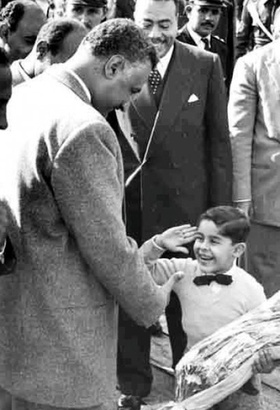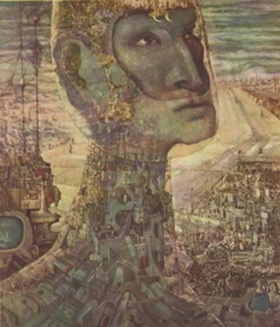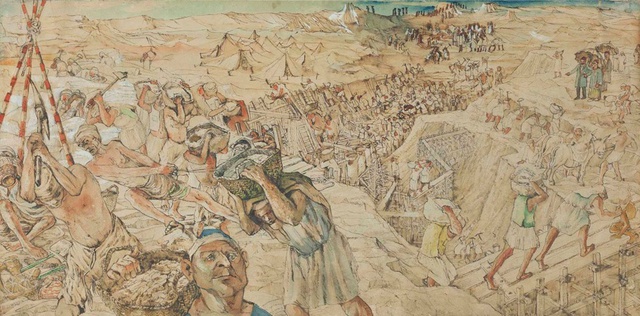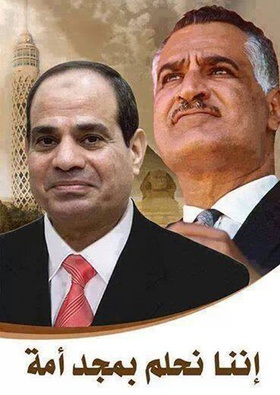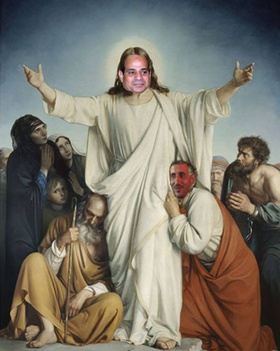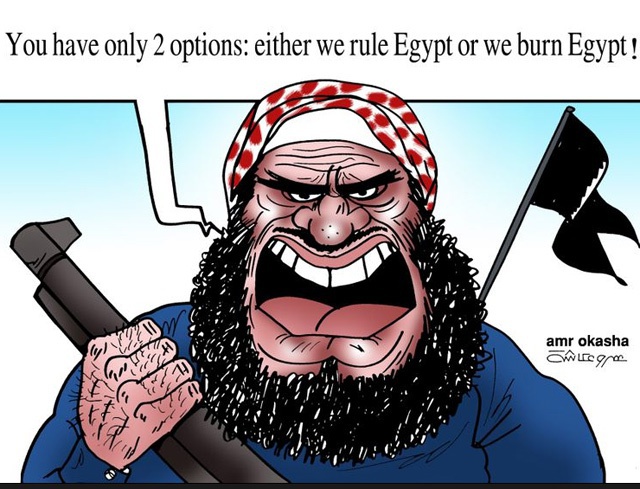Essays
Future Fiction
In the Shadow of Nasser
Were we to revisit Arab iconography from the 1950s and 1960s, images of Egyptian president Gamal Abdel Nasser greeting adoring crowds or attending an Umm Kulthum concert would come to mind. Raising his hands cheerfully and victoriously, Nasser was seen not just as the president of Egypt but a leader of all Arabs. A heroic figure who stood up against colonial powers during the tripartite aggression of 1956, he restored Arab dignity and activated a narrative of historical agency, empowering people to work, fight, and dream.[2] No leader had captured Arab imagination more powerfully than Nasser. And there is no love for a leader greater than the love for Nasser. When he was defeated in the war against Israel in 1967, the Arabs cried; and when he passed away in 1970, they fell into despair.
With the Arab uprisings starting in 2010, Nasser's iconography reappeared in full force, circulating through images and recorded speeches on YouTube. In one video, he can be seen mocking the Muslim Brotherhood, berating them, and joking that they want women to veil but can't even control them.[3] And since the Brotherhood were deposed by the army in June 2013, the iconography of Nasser has come to blend with and inform the iconography of Abdel Fattah al-Sisi, the army general and newly-elected president who is increasingly presented as Nasser-like. Sisi is currently conceived as the 'man of the hour' who could potentially continue Nasser's legacy and save Egypt from chaos and collapse just as Nasser did when he came to power in 1952 after a long period of violence and instability.
Examining images from the 1960s may hold the key to understanding the resurgence, recycling, and recoding of Nasser's iconography as a way of legitimizing contemporary forms of authority. Such visual analysis, of course, could not be undertaken comprehensively in one essay. Sketching a critical trajectory to be explored further, I engage with the way in which a particular Arab nationalist fiction – the fiction of the future traditionally portrayed by Nasser – is being recast today with Sisi. Specifically, I ask, to what extent is Sisi's imagery and comparison with Nasser part of an attempt to reactivate a fictional model that allows Egyptians to reconnect with both past and future, move forward, and heal after the 25 January 2011 revolution? What kind of model of salvation is Sisi offering the Egyptian public, and would it fulfil the aspirations and demands expressed by the uprising associated with the so-called Arab Spring?
Nasser's Stage
Intellectual historian Yoav Di-Capua argues that 'Nasser's fantastic politics willed the nation into existence in a manner which conceived of the general will as intimate liberation of the self.'[4] The heroic Nasser, beloved by millions (habib al-malayin), defending the poor and fighting foreign aggressors, is a powerful fiction that shaped the production of the Arab self in the second half of the twentieth century. To say it's a fiction, however, doesn't make it more or less true, more or less powerful. A charismatic leader who came to power after a military coup that deposed King Farouk in 1952, Nasser inspired the people in speeches but also in accomplishments, ranging from the Cairo Tower (1961) to the Aswan Dam (1970). Politics for Nasser became a spectacle of inauguration (tadshin) of this bridge and that factory, this road and that school. This Nasserist exhibitionism and populist defiance gave the people the possibility to dream and imagine themselves as actors in a historical and social drama that will lead to progress, victory, and justice for all.
Nasser himself acted as a hero of a fictional narrative. His main inspiration was the character of Muhsin in Tawfiq al-Hakim's novel, 'Awdat al-Ruh ('The Return of the Spirit') (1933), which is based on the 1919 anti-colonial revolution in Egypt. The novel presents a national narrative centred on the romantic heroism and devotion of the Egyptian subject embodied in the character of Muhsin. Inspired by this and other works, Nasser tried his hand at fiction, writing a novel entitled, Fi Sabil al-Hurriyya ('Towards Freedom') (1959), and naming his main character Muhsin as well. Al-Hakim writes that the character Muhsin in his novel transformed with Nasser into a real-life figure, equally embodying 'the passionate and impulsive patriotic hero.'[5] 'As he rose to prominence,' argues scholar Margaret Litvin, 'drama was never far from Nasser's mind.'[6] Discussing his 1954 book, Falsafat al-Thawra ('The Philosophy of the Revolution'), Litvin emphasizes the role of fiction in buttressing Nasser's perception as national hero. Quoting Nasser: 'For some reason it seems to me that within the Arab circle there is a role, wandering aimlessly in search of a hero. And I do not know why it seems to me that this role, exhausted by its wanderings, has at last settled down, tired and weary, near the borders of our country and is beckoning us to move, to take up its lines, to put on its costume, since no one else is qualified to play it.'[7] Nasser's power, legitimacy, and appeal are thus intimately tied to a historical narrative in which he is cast – and cast himself – as hero. To play this role is to answer the call of history, which requires him to act both as folk hero, father of the nation, and leader of the Arabs if not of the entire third world whose cause he championed. Nasser's appeal is thus grounded in this fictional narrative that he consciously sustained throughout his rule.
Tawfiq al-Hakim goes even further in identifying the power of this narrative and its effects on the people:
[Nasser] bewitched and captivated us as if in a dream without us realizing. Perhaps it was his magic, as some claimed. He made us live in a fantasy world of aspirations and promises, painting a beautiful picture of the accomplishments of his revolution. The propaganda machine, with all its fanfare, chants, songs, and films, made us believe that we live in a great industrial country, leading the developing world in agricultural reform, and the mightiest military power in the Middle East. The face of the worshiped leader filled TV screens as he stood high on podiums and sat in meeting rooms, talking for long hours, telling us tales and explaining how we were and what we have become, without anyone arguing, correcting, or responding. We had no choice but to believe and burn our palms in the fire of applause.[8]
This power of dreaming was fundamental to Nasser's appeal. His ability to cast himself in a historical narrative promised to raise the Arab subject to the sky, as high as the Aswan Dam that generated power to Egypt, harnessing nature for industrial progress. But also as high as the Cairo Tower, home of Voice of the Arabs, the radio station that broadcasted his speeches to all Arabs.[9] In dreaming Nasser's dream, the Arab subject would erase the scars of colonialism, defeat, and poverty. Modernity in this pan-Arab framework turned into a historical narrative made up of actors cast from across the Arab world, sharing the power to dream by rising above their material realities no matter how hard and destitute they were. Arab modernity was a narrative of the future, enlightenment, and a utopia tied to what Nasser achieved and inspired. This is best captured in the art of Egyptian painter Abdel Hadi al-Gazzar shown below. More importantly, Arab modernity became a literary genre centred on Nasser, the romantic hero and saviour worshiped by millions.
The narrative of the future that Nasser embodied has deep roots in utopian thought and Egyptian history. From the pyramids and the pharaonic temples attributed to the gods and extra-terrestrials in popular imagination, to the intersection of European expansionism and utopian thought in the eighteenth century, Nasser's dream was intertwined with a vision that was appropriated by different historical agents at various times. Bearing in mind that the Saint-Simonians[10] played a role in the building of the modern Egyptian state and army by coming to Muhammad Ali's court in the nineteenth century, Napoleon invaded Egypt in 1798, hoping to link the future and the past. Napoleon's engineers during the occupation (1798-1801) did a study for a canal that would link the Red Sea and the Mediterranean. This utopian plan that would be embodied in a universal project of trade, exchange, as well as world domination, was conceived by the French and designed by Ferdinand de Lesseps. Inaugurated in 1869 as a world event, the Suez Canal could be viewed in this light as an embodiment of a utopia. When he landed in Egypt in 1833, the Saint-Simonian high priest, Barthélémy-Prosper Enfantin, described 'Egypt as the perfect setting for the next phase in world history.'[11]
Nationalizing the canal in 1956 was Nasser's attempt at harnessing this utopia, reclaiming it for the future of Egypt and all the Arabs. The nationalization of the canal was staged as a performance that took place right after Western powers had denied Nasser funds to build the Aswan Dam, his utopian project that would rival the pharaonic temples nearby. On 26 July 1956, Nasser gave the famous speech that resulted in the nationalization of the canal and the 1956 war involving France, Britain, and Israel. It was agreed that when he mentioned the name of the canal's architect, Ferdinand de Lesseps, the army units would recognize the code and move to take control of the Universal Company of the Suez Maritime Canal. The canal was thus nationalized before the end of the speech. This staging of the canal's nationalization, an act of anti-colonial resistance though mired in Cold-War politics, transforms Nasser's utterances to magic words with specific material effects and historical implications. The code word, 'Ferdinand de Lesseps,' thus ties in Nasser's revolution to the utopian manifestations of the French Revolution and their incarnation with Napoleon and eventually de Lesseps. Nationalizing the canal restored it to its rightful owners – descendants of the million Egyptians who built it with their sweat and blood.[12] It also activated a historical fiction that would now align Napoleon, Muhammad Ali, Père Enfantin, de Lesseps, Khedives Said and Ismail, and, finally, Nasser. This political and economic act is thus inseparable from a historical narrative, a stage upon which Nasser would perform his magic, and fulfil the role of the revolutionary leader of a modern nation with an identifiable teleology linking past and future.
Naksa's Derailing Fiction
The Arab defeat in the war against Israel in 1967 or Naksa (setback) is often associated with the collapse of the project of Arab enlightenment and progress that could be traced to the nineteenth century. The reading of this momentous event ties military defeat to the interruption of Arab modernity. This interpretive model, however, has come under much scrutiny by scholars in recent years. But what the Naksa did expose is Arab modernity as a dream machine tied to Nasser's utopian, romantic, and nationalist fiction. The Naksa brought about the collapse of the Nasserist narrative of the future that engendered the Arab subject in the 1950s and 1960s. When Nasser realized the magnitude of the defeat in 1967, he turned to his generals and said: itfadahna (we've been exposed, stripped naked, scandalized). The scandal and nudity here mark the end of the fairy tale, the collapse of a dream and its ability to bewitch and captivate. The defeat is thus an interruption if not collapse of a particular kind of fiction associated with Nasser. Naksa as fadiha (scandal) revealed what was behind the curtain, taking Arab viewers backstage. But what were they able to see? Did it expose the mechanism that buttressed the Wizard of Oz and allowed him to practice his magic in word and deed?
The Naksa was so catastrophic not only in terms of land loss – including the loss of the Suez Canal – but also because it was Nasser's defeat, his pain and collapse from those high podiums from which he appeared on TV screens. What was unbearable was not, therefore, the fact that the Arabs were set back in their modern project of progress and enlightenment as it is believed, but that Nasser was defeated, wounded, exposed, and kicked off stage. The covers from Cairo-based, social and political magazine Rose El Youssef from June and July 1967, best capture the inscription of the defeat through metaphors of wounding, scaring, and devouring centred on the bodies of Nasser and of the Arab nation.
In the image above, the man is wearing a shirt that says, 'the Arab people.' We can see the symptom of the defeat on the Arab subject as his trigger finger has been wounded. 'The traces of aggression' (athar al-'udwan) are thus brushed aside as a mere wound to the finger. Reducing its effects to a scarred finger, this image implies that the Naksa failed to defeat the Arab subject who continues to stand defiant. In the other image, Israel is depicted as a mad dog gnawing away at Arab land likened to a bone. This image suggests that all the enemy was able to acquire was a bone, thrown at a hungry dog. Read together, these covers imply that the Arab subject and land escaped almost unscathed from the war against Israel. Brushed aside in such a manner, the traces of the aggression thus point to much deeper scars and wounds that are both physical and psychological but that need to be suppressed, veiled, and left out of the picture. This iconography sustains a structure of denial that refuses to acknowledge the defeat's catastrophic effects.
While he was loved and revered since he came to power, the defeat of 1967 ushered in unconditional love for Nasser, one that is detached from Muhsin's dream of a glorious future. With or without the Arab enlightenment narrative, with or without the future, and with or without Gaza, Sinai, the West Bank and the Golan – all the territories captured by Israel during the Six Day War – the Arabs would now love Nasser as someone who needs care and protection, covering his mortal wound. This unconditional love meant that he could not be held responsible for the catastrophic defeat even when he had admitted his failure. This denial made possible the displacement of responsibility through conspiracy theories ranging from the inadequacy of his generals (especially, Abdel Hakim Amer) to the treachery of the Russians who sold him bad armaments – rumours that continue to circulate today.
In 1967, Nasser delivered his famous speech in which he took responsibility for what had happened and resigned. But the people 'refused' Nasser's resignation and put him in their hearts, transforming him from the powerful president and father of the nation to a child-like figure who could do nothing wrong.[13]
These caricatures best capture the reaction to Nasser's defeat. They depict the people pleading with Nasser to stay in power, as if to reinforce the structure of denial, or, much worse, as if to say: 'We don't care of you lose all Arab lands, we love you anyway!' The displacement and the blame are clearly directed at America, Israel, or even Abdel Hakim Amer and the Russians, who all plotted to hurt Nasser. Thus, to be truly defeated is to allow this plot to succeed and Nasser to step down. To triumph, on the other hand, meant keeping Nasser in place, holding on to him as one holds on to a beloved child who bears no responsibility for his actions and decisions. The Arabs are thus put in the position of having to sacrifice their land and future – and even their own lives – so that 'not one hair of Nasser's head shall be touched,' as one headline read. In this sense, the Naksa ended the narrative of the future, sabotaged the dream machine, only to keep 'Nasser Nasser Nasser' alive. From the stage of Arab history, after the Naksa Nasser moved to the hearts of his adoring public where he would live forever. Unable to sustain the role Nasser was cast to play, the fiction that tied him to the people gave rise to a new model of ties, affection, and love. From the position of national hero, post-1967 Nasser occupies the position of the blameless child requiring unconditional love. This event marks the death of the father and the birth of the despotic child, a model that will be reproduced across the Arab world.
The Arab Uprisings: Reactivating the Future?
The Arab uprisings that erupted in 2010 bore within them the promise of breaking with the legacy of the Nasserist revolution, dream, and ensuing defeat, in order to reinvent the Arab future. The Yom Kippur war in 1973 constituted a military victory for Egypt and allowed it to recapture the Suez Canal. Despite 'crossing the canal,' which led to the peace treaty with Israel in 1979, social and political stagnation ensued throughout the Sadat and Mubarak years. In 2010, the people rose against dictatorial regimes and the lack of faith in a better future. More powerful than any demand, the call for dignity, hope, and aspiration was the most resonant, leading men and women from across social strata to take part and unseat aging despots stuck in the past. Out of sync with their societies and unaware of youth power and the technological developments that have engendered new models of subjectivity, Arab rulers and bureaucrats belonged to the generation of defeat, sustaining their power by maintaining the status quo. The Arab people rose to forge a new historical agency that has been hijacked by corruption and authoritarianism.
The call for a new conception of historical agency and social and political order had been brewing since the late 1990s, taking shape in art, literature, film, and in social and political movements such as Kifaya and, later, April 6.[14] Egyptian author Ahmed Alaidy's 2003 novel, Being Abbas el-Abd, captures the mood of discontent that would set the stage for the eventual eruption. A character in Alaidy's text proclaims at one point:
You want us to progress? So burn the history books and forget your precious dead civilisation. Stop trying to squeeze the juice from the past. Destroy your pharaonic history […] We will only succeed when we turn our museums into public lavatories.[15]
The violent break with Egypt's past as a romantic national fiction also involves, according to Alaidy, a complete dissociation from the 'generation of the Defeat.' In a reference to the 1967 war, Alaidy writes: 'Egypt had its generation of the Defeat. We're the generation that came after it. The "I've-got-nothing-to-lose generation." [...]. You need to UPGRADE your wisdom and UPDATE your experience.'[16] Here, the character of Abbas in Alaidy's text, using the computer language of hardware and software, presents the past as weight that suppresses the future. In this way, he identifies the means by which a model of Egyptian identity, which breaks along generational lines, seeks to overcome a particular historical narrative that holds it hostage. The pan-Arab articulation of modernity, Nasser's revolution, and the discourse on progress are all exposed in Alaidy's and his generation's texts and social and political practices as slogans that no longer resonate with the new realities of the Arab world. Anger and frustration at an ossified social and political system tied to the past explode in new forms of writing, and, eventually, in uprisings in Arab streets and squares.
People like Alaidy who took to the streets in January 2011 truly represent the spirit of the Arab uprisings, which continue to survive despite authoritarian practices, civil wars, and the general instability that currently mires the region. What was referred to as 'the Arab Spring' emerged as a movement demanding a new narrative of the future, which is neither utopian nor ideological as is the one discussed in the context of Nasser. Following Alaidy's words, this new narrative ought to break with a past that is tied to pharaonic history and the colonial project that invested it with the utopian thought and expansionist practices from Napoleon onward. Its cathartic violence directed at history books and the way that history is written and taught, seeks to de-territorialize the historical fiction that ties Egypt to a military genealogy of conquest, wars, and defeats, from Napoleon to Sadat and beyond.
Though the resignation of Mubarak on 11 February 2011, announced a new dawn in the Arab world and in Egypt specifically, the rule of the Supreme Council of the Armed Forces (SCAF), the Muslim Brotherhood, and then the military again under Sisi has undermined the prospects for a better future. Perhaps it is part of any revolution to go through these turbulent times, but there is less and less hope for the success of the revolution. For instance, April 6 movement, a group that was instrumental in mobilizing for the revolution, was outlawed in April 2014. Consolidating power, Sisi is increasingly presented as the 'man of the hour' and saviour of Egypt whose advent has been foretold in ancient texts. Moreover, some are going as far as analysing his first name, Abdel Fattah, 'Fattah' as in fataha, fatih, futuhat (to conquer, conqueror, Islamic conquest), legitimizing his power through divination, mysticism, and a history of conquest that goes back to the rise of Islam.[17]
Sisi rose to prominence during Muslim Brotherhood president Muhammad Morsi's brief term (2012-2013). This period produced another set of images and conspiracy theories about the Brotherhood. Literature, TV, and social media deployed to expose the Brotherhood as an evil sect trying to dismantle the Egyptian state. Bestselling books such as Tharwat al-Khirbawi's Sir al-Ma'bad ('Secret of the Temple') and Charles Fouad al-Misri's Al-Ab al-Ruhi ('The Spiritual Father'), both published in 2012, present the Brotherhood as having long conspired to control various government institutions from the police to the army. Moreover, a development project in the Suez Canal that was highly mediatized at the beginning of 2013 further demonized the Brotherhood. The media circulated reports about the Brotherhood's intention to sell the Canal to Qatar who would fund a gargantuan development project consisting of extraction of raw material, factories, and ports. Of all the political blunders and violations committed by Morsi and his cohorts, the Suez Canal project raised the most alarm, leading critics to decry a Qatari takeover that would threaten Egypt's sovereignty and national security. The Brotherhood, in this light, were represented as reversing the historical narrative tied to the utopian framework within which the canal has been produced in the Egyptian imagination. An article in Al-Ahram declared, 'It was only when Minister of Defence General Abdel-Fattah Al-Sisi announced last week that the army would never abandon the canal that public anxieties began to subside.'[18] The need to save the canal from the scheming Brotherhood and their Qatari backers played an important role in the campaign to delegitimize and overthrow them. This campaign required a leader, a hero that would save the nation and defeat the conspirators. Abdel Fattah al-Sisi, the defence minister who enacted their overthrow, stepped in to perform this role and reactivate a utopian narrative tied to Nasser's nationalization of the canal and Sadat's crossing it in the 1973 war. The coup of June 2013 was thus staged like a mega-concert, a production complete with helicopters hovering above, laser shows, and throngs of spectators filling streets and squares. It was to usher in an act of colossal proportions.
Sisi Mania
The political landscape in Egypt today is reminiscent of Nasserist times in more ways than one. The army coup of 1952 could not be ignored when considering the coup in June 2013 against the Muslim Brotherhood. In both cases, the army allegedly intervened to 'save the nation' or forge a new social contract. As Nasser later wrote, defending the army's intervention in politics: 'I can say now that we did not ourselves define the role given us to play; it was the history of our country which cast us in that role.'[19] Rising to the occasion in order to play a historical role is again presented as a casting that comes from a narrative that interpellates its characters, assigning them various roles. Just as history had summoned Nasser and his fellow officers, it seems to be summoning Sisi and the army today. It is through this process of casting and summoning that the salvation of the nation will be realized, requiring a new set of sacrifices.
The image below of Sisi as the virile conqueror (fatih) best captures the resurgence of the narrative of salvation. The caption of the image, from right to left, reads rais (leader, president, which was the term used for Nasser) dakar, which means 'male' (a term normally used for animals); arusa amar means 'beautiful bride,' in reference to Egypt, which he carries on a white horse; and w hiyya di masr ya amrikanya ghagar, which means, 'and this is Egypt, you Americans, you morons.'[20] We see the continuity with the other generals on the pyramids in the background – Nasser and Sadat – highlighting a genealogy in relation to the army officers turned presidents of Egypt. This takes us back to the discourses of nationalism in Egypt at the beginning of the nineteenth century, with the pyramids becoming not just a place where peasants kept their sheep but as part of an ancient cultural heritage that continues into the future.[21] The image frames the advent of Sisi through the institution of the army, which was one of the first institutions of modern Egypt that Muhammad Ali, who came to power in 1805, helped build.
The army genealogy is tied in this image to sexual conquest, wherein Sisi not only carries the bride but is also the one who will be able to consummate the marriage in ways that others – from outside the military institution, namely Morsi – cannot. Sisi as 'Prince Charming' has his own image on the pyramid as well. The illustration in this context seeks to reactivate the future, linking it to the past through the army and a narrative of Arab modernity tied to the pyramids and the utopian project that shaped the founding of the state and its institutions and later harnessed by Nasser. But the fiction that sticks is that of the conqueror who doesn't carry the bride willingly but wins her as a trophy or as the spoils of war. Should we scrutinize the image further, we see war scenes in the lower part of the illustration, which could date back to colonial times. Here, Sisi is the saviour but also the one performing an act of colonial blunder, carrying his bride after a colonial if not Napoleonic conquest (fath). One wonders, in this sense, if it is not Napoleon's ghost rather than Nasser's that has come to haunt the new national saviour.
The fiction of 'Prince Charming' thus emerges as a cover for an act of colonial blunder. Sisi's attempt to perform the role of the hero continuing the legacy of Nasser and Sadat is both staged and exposed in this image as an act of conquest. It also presents Egypt as a theatre of violence and stolen history as in colonial times. The image of Sisi on the pyramid looking at himself riding away points to his own dream and fantasy as saviour and worthy heir of Nasser. However, according to this image, Sisi is engaging in an act of theft of antiquities (the mask of King Tut) disguised as a nationalist narrative of liberation. The image of Sisi carrying Egypt – the groom carrying his bride – thus reveals an odd couple. In its attempt to fictionalize Sisi, this image tafdah (strips naked) the act of fictionalization itself, reducing it to an act of brute force involving kidnapping, theft, and colonial conquest.
Examining other illustrations of Sisi circulating today points to an attempt to activate a fiction in which Sisi answers the call of history that has previously summoned Nasser. He's Jesus Christ or The Lion King's prince Simba, who finally returns to defeat the usurper and reclaim his throne in the film. These systematic attempts cast Sisi in a historical role, beckoning him to save the nation and bring back the future in its utopian dimension from the pyramids to the Aswan Dam and beyond. The narrative of 'Prince Charming' and that of the saviour reveal the attempt to fictionalize rather than the success of fictionalization. And while Sisi is cast to perform the role of the Nasser-like saviour of the nation, the Muslim Brotherhood are cast as usurpers who need to be deposed and eliminated for national healing and stability to occur.
The Muslim Brotherhood are also incorporated into these attempts at reactivating fiction and restoring the future with Sisi as its hero. They too have a role to play in this historical narrative as they did during the time of Nasser who dismissed and persecuted them, accusing them of treason following the attempt on his life in Alexandria in 1954. On this new stage, they are cast as an evil gang that needs to be disciplined, beaten, if not destroyed as in a film or video game. Given the iconography emerging from Egypt after 2011, they look unkempt, in fact, abject. While Sisi is cast as the colonial conqueror, the Brotherhood's depiction harkens back to European orientalist paintings from the nineteenth century or Hollywood representations of Islamic terrorists.[22] In sharp contrast to the image of masculinity in its nationalist modern framing that Sisi is meant to embody, the Brothers are radically othered, represented as a polygamous lot, sitting on the floor in their protest tents, and looking evil and dishevelled.
This representation became most poignant during the violent break up of the Rabi'a al-'Adawiyya sit in August 2013. Breaking up this sit in by the Egyptian army under Sisi was called fadd al-i'tisam. Fadd means 'breaking up' but also 'deflowering' (as in fadd al-khitam), wherein the act of ending a protest coincides with an act of violent deflowering or rape as in a conquest. In this sense, Sisi emerges as the conqueror of a barbaric horde. Just like the colonial process that unfolded from orientalist representations of the East, the othering of the Brotherhood – their depiction as unkempt and dishevelled, terrorists and traitors – turn them into legitimate targets of brute force. The Brothers are cast as the bad guys in the fiction that is unfolding and that is seeking to present Sisi as saviour and hero likened to Nasser.
Conclusion
Whereas Nasser was associated with a fiction of the future that was powerful despite its propagandist framework until 1967, we move with Sisi's iconography to the fiction of the conqueror who requires unconditional love as he disciplines and wipes out the enemy. This fiction justifies a carte blanche for Sisi to end chaos: eliminating his opponents and establishing his legitimacy through violent subjugation. In this image above, the child, associated traditionally with the future, is an obeying soldier who will support his leader at any cost. It is also Sisi as a child who will be granted unconditional love and loyalty as long as he quells resistance and leads Egypt into the future. But what kind of future is returning in this new guise, and is it able to produce the stability and hope that the people have come to expect after their momentous uprising?
Considering these illustrations, one could argue that Sisi is rehearsing for a narrative of salvation that is out of sync with the Arab public. When looking closely at Sisi's iconography we see ridicule; the images are satirical, mocking his attempts at playing a historical role in the shadow of Nasser. Ridicule and satire expose the systematic failure to cast Sisi as the new Nasser. Unable to fill his shoes, the new ruler rehearses incessantly for his part in a narrative that was always fraught, utopian, and tied to a colonial history from which it is unable to break. Re-enacting the dynamic of the 1950s by consolidating power and persecuting political rivals, the new ruler is reduced to a show of brute force lacking vision, hope, and a future. The Arab people rose from 2010 onward against authoritarian rule, demanding dignity and freedom. Will they relinquish these demands and convince themselves that the king is wearing his clothes again? Only time will tell.
[1] ‘In the photo, Al Sisi is just a little boy of maybe 4 or 5 years old, he is saluting Jamal Abdel Nasser and getting ready to hand him a bouquet of flowers during celebration of the Anniversary of July 23rd revolution.’ Sami Mubayed, ‘The Ghost of Gamal Abdul Nasser,’ The Huffington Post, 30 July, 2013: http://www.huffingtonpost.com/sami-moubayed/the-ghost-of-gamal-abdul-_b_3667639.html.
[2] For a good introduction to Nasser, see: Joel Gordon, Nasser: Hero of the Arab Nation (Oxford: Oxford University Press, 2006).
[4] Yoav Di-Capua, 'Sacred Politics, Unholy Freedom,' unpublished paper, 2014. I'm deeply grateful to Yoav Di-Capua for his insightful comments and suggestions that helped shape this essay.
[5] Tawfiq al-Hakim, Awdat al-Wa'i (Return of Consciousness) (Cairo: Dar al-Shorouk, 1974), 39-40 [author's translation].
[6] Margaret Litvin, Hamlet's Arab Journey: Shakespeare's Prince and Nasser's Ghost (Princeton: Princeton University Press, 2011), 40.
[7] Ibid., 41.
[8] Al-Hakim, Awdat, 47-48 [author's translation].
[9] Although the station started broadcasting in 1953, it's only in 1963 that it was modernized and turned into a 24-hour station able to reach all Arab countries. Though it continues to operate till this day, it lost much of its credibility after the defeat against Israel in 1967. See Douglas A. Boyd, 'Development of Egypt's Radio: 'Voice of the Arabs' under Nasser' (Journalism & Mass Communication Quarterly1975, 52: 645-653).
[10] An order of utopian engineers founded in the eighteenth century in France. Its members were instrumental in project development but also in French colonial expansion and policies in the nineteenth century. For a recent publication discussing their origin and influence in Egypt and Algeria especially, see: Pamela Pilbeam, Saint-Simonians in Nineteenth-Century France: From Free Love to Algeria (New York: Palgrave Macmillan, 2013). I also would like to acknowledge Ahmad Naji's talk on sci-fi and utopian elements in Egyptian state discourse and development projects from the nineteenth century to Nasserist times. See: 'How to Write the Future,' 98 Weeks, 21 May 2013: http://www.98weeks.net/2013/11/workshop-open-call.html.
[11] Zachary Karabell, Parting the Desert: The Creation of the Suez Canal (New York: Knopf, 2003), 35.
[12] For a moving scene about the significance of the Suez Canal nationalization, see this clip from the film, Nasser 56 (Dir. Mohamed Fadel, Egypt, 1996).
[13] There is controversy on this, but most historians agree that the demonstration that came out to support him were not entirely staged, and that his public support continued despite the defeat.
[14] Kifaya (enough) is the Egyptian Movement for Change founded by writers, politicians, and activists in 2004 in order to protest the government's corruption and the then-planned transfer of power by Hosni Mubarak to his son Gamal. The April 6 Youth Movement, affiliated with Kifaya, was founded in 2008, and played a key role in the protests that led to Mubarak's ousting.
[15] Ahmed Alaidy, An Takun Abbas al-'Abd (Being Abbas el Abd), trans. Humphrey Davies (Cairo: American University of Cairo Press, 2006), 36.
[16] Ibid.
[17] See: JoeTube, 16 January 2014 https://www.youtube.com/watch?v=FPSZccV2G-k.
[18] Ahmed Eleiba, 'Where is the Truth?,' Al-Ahram Weekly, 31 January 2013 http://weekly.ahram.org.eg/News/1252/17/Where-is-the-truth-.aspx.
[19] Litvin, Hamlet, 40.
[20] For a book discussing the perception of Egypt as a woman, see: Beth Baron, Egypt as a Woman: Nationalism, Gender, and Politics (Berkeley: University of California Press, 2007).
[21] For an insightful work on this topic, see: Malcom Reid, Whose Pharaohs?: Archeology, Museums, and Egyptian National Identity from Napoleon to World War I (Berkeley: University of California Press, 2002).
[22] See Edward Said, Covering Islam: How the Media and the Experts Determine how we See the Rest of the World (New York: Pantheon Books, 1981) and Reel Bad Arabs: How Hollywood Vilifies a People (Dirs. Jeremy Earp and Sut Jhally, USA, 2006).

